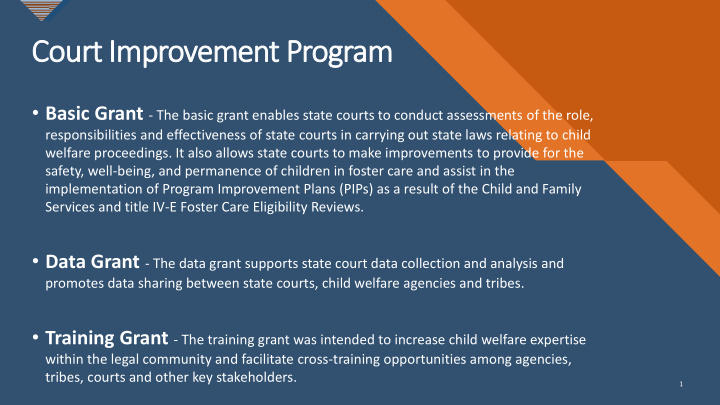



Court Improvement Program • Basic Grant - The basic grant enables state courts to conduct assessments of the role, responsibilities and effectiveness of state courts in carrying out state laws relating to child welfare proceedings. It also allows state courts to make improvements to provide for the safety, well-being, and permanence of children in foster care and assist in the implementation of Program Improvement Plans (PIPs) as a result of the Child and Family Services and title IV-E Foster Care Eligibility Reviews. • Data Grant - The data grant supports state court data collection and analysis and promotes data sharing between state courts, child welfare agencies and tribes. • Training Grant - The training grant was intended to increase child welfare expertise within the legal community and facilitate cross-training opportunities among agencies, tribes, courts and other key stakeholders. 1
“ The purpose of the Court Improvement Project Taskforce is to provide a forum to consider issues, review data, develop plans and promote system enhancements related to deprived and delinquent/unruly youth in order to improve outcomes for North Dakota children and families. 2
Areas of Focus for CIP – A Data Driven Approach Timeliness to Dual Status Youth Indian Child Quality Legal Permanency in Initiative Welfare Act Representation Deprivation and Plan Termination of Parental Rights Cases 3
Collaboration with Title IV-B/IV-E Agency and Tribes • State courts/CIP must demonstrate collaboration with the title IV-B/IV-E agency and Indian tribes in applications for CIP funding by describing how the title IV-B/IV-E agency and tribes, where applicable, will be involved in CIP planning, including: • identifying needs; • developing theories of change; • selecting or developing solutions; • planning, preparing and implementing change; and • evaluating and applying findings. • State courts must also commit to participating in all stages of child welfare program planning and improvement efforts, including the CFSP/APSR, CFSR and title IV-E Foster Care Eligibility Review processes within required timeframes. 4
INTERVENTIONS THERAPUTIC REUNIFICIATION BEHAIVORAL TIMELINES HOPE STATES SELF-SUFFICIENCY ATTORNEY DSY F AMIL Y CENTERED ENGAGMENT TRAUMA DRAWING ENGAGING COMPLEX NEEDS HOPE DEPRIVED UNRULY SHELTER CARE GUARDIAN PARENTS JUVENILE COURT SUCCESS IDENTIFICATION GOAL VISION TEAMWORK CHILD WELFARE LEGAL FINDINGS MULTI-DISCIPLINARY TEAM TEAM
Dual Status Youth Initiative Children and youth who come into contact with both the child welfare and juvenile justice (delinquency) systems. They may have different types of contact or legal statuses within these systems including: Dual identification Dual involvement
Complex Needs of this Population… Have experienced complex trauma ~ Repeated or prolonged trauma at significantly higher rates than others. Complex trauma is associated with behavioral problems that can bring youth into the juvenile justice delinquency system. Child maltreatment has been shown to increase the likelihood of arrest as a juvenile by 59% and as an adult by 28%. Maltreated children tend to be : ~ Younger at first arrest ~ Commit more offenses ~ Experience more frequent arrests
Outcomes… DSY are removed from their homes more frequently. Impact on educational, employment and self-sufficiency. Detained more frequently. Greater reliance on public systems. Stay in detention for longer periods of time. Child Welfare and Juvenile Justice Systems are not typically designed to coordinate, share info and collaborate to assure effective delivery of services.
ND’S Dual Status Youth Initiative ND Supreme Court ND Department of Human Services ND Division of Juvenile Services ND Juvenile Justice State Advisory Group Robert F Kennedy National Resource Center for Juvenile Justice
Highly Responsive Trauma Informed to Therapeutic Care Interventions Developmentally Agency Appropriate Coordinated Care Interventions ND’S Dual Status Youth Initiative
1.Current and historical delinquent/unruly referrals 2.Type of abuse or neglect that occurred 3.Status of social services report and assessment 4.Services being provided or offered 5.Current and ongoing concerns 6.Parental cooperation with assisting in completion with case plans 7.Safety issues in regards to parent and/or juvenile Information Shared between Agencies
Goals of MDTs and FCEs Reduce the number of child ildren enterin ing foster care In Increase the number of child ildren remaining safely in in their ir own homes For child ildren that are removed, , in increasin ing the number pla laced wit ith rela lativ ives.
February ry 1, , 2019 to February ry 29, , 2020 • Percentage of juvenile court referrals where a child was considered Dual Status: 44%
2019 Initiative findings: ✓ Less likely to be removed from their homes and placed in foster care; ✓ More likely to have their cases diverted; ✓ Less likely to be ordered into the custody of juvenile corrections or the social service system.
The proportion Dual status Native 40% of all of dual status youth new American referrals were youth females and youth are 2.5 due to unruly has increased subsequent times more offenses by 7% since referrals drop likely than 2015. significantly in White youth the summer to be dual months. status.
Future Goals: : Utilize DSYI data to address gaps in resources and guide conversations among the Children’s Cabinet, Juvenile Justice Commission, Court Improvement Program Taskforce, and agency leadership as they work to identify areas for policy and practice development which may include: ✓ Eliminating the incarceration of female youth ✓ Decriminalizing unruly behavior ✓ Addressing disparities and disproportionality among minority youth ✓ Increasing access to behavioral health services including developing ample mental health and substance abuse services
Recommend
More recommend